26. Learn Python, Break Python by Scott Grant
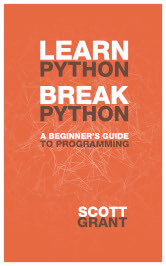 Learn Python, Break Python is a hands-on introduction to the Python programming language, written for people who have no experience with programming whatsoever. Hey, we all have to start somewhere. As such, the examples and teaching style used in this text make absolutely no expectations about your prior programming experience.
Learn Python, Break Python is a hands-on introduction to the Python programming language, written for people who have no experience with programming whatsoever. Hey, we all have to start somewhere. As such, the examples and teaching style used in this text make absolutely no expectations about your prior programming experience.
Learn Python, Break Python starts with a gentle introduction to programming. Slowly, through examples and exercises, we build up to a level of comfort by introducing more complicated program elements, and show where they can be used and how we can break them. By building up knowledge in this way, we hope to impart a level of comfort that will make you comfortable trying new things and taking risks; in short, we want you to be comfortable with programming.
27. How to Make Mistakes in Python by Mike Pirnat
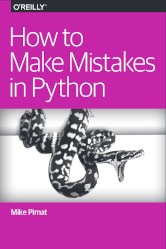 First, this work does not aim to be an exhaustive reference on poten‐tial programming pitfalls—it would have to be much, much longer,and would probably never be complete—but strives instead to be ameaningful tour of the “greatest hits” of the author’s sins.
First, this work does not aim to be an exhaustive reference on poten‐tial programming pitfalls—it would have to be much, much longer,and would probably never be complete—but strives instead to be ameaningful tour of the “greatest hits” of the author’s sins.
The author’s experiences are largely based on working with real-world but closed-source code; though authentic examples are used where possible, code samples that appear here may be abstracted and hyperbolized for effect, with variable names changed to protect the innocent.
28. A Whirlwind Tour of Python by Jake VanderPlas
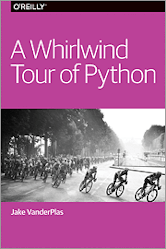 A Whirlwind Tour of Python is a fast-paced introduction to essential features of the Python language, aimed at researchers and developers who are already familiar with programming in another language. The material is particularly designed for those who wish to use Python for data science and/or scientific programming, and in this capacity serves as an introduction to the author’s longer book, The Python Data Science Handbook.
A Whirlwind Tour of Python is a fast-paced introduction to essential features of the Python language, aimed at researchers and developers who are already familiar with programming in another language. The material is particularly designed for those who wish to use Python for data science and/or scientific programming, and in this capacity serves as an introduction to the author’s longer book, The Python Data Science Handbook.
This book is released under the “No Rights Reserved” CC0 license, and so you are free to re-use, modify, build-on, and enhance this material for any purpose.
29. Program Arcade Games With Python And Pygame by Paul Vincent Craven
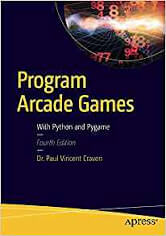 Dr. Paul Vincent Craven teaches you how to create fun and simple quiz games; integrate and start using graphics; animate graphics; integrate and use game controllers; add sound and bit-mapped graphics; and build grid-based games.
Dr. Paul Vincent Craven teaches you how to create fun and simple quiz games; integrate and start using graphics; animate graphics; integrate and use game controllers; add sound and bit-mapped graphics; and build grid-based games.
After reading and using this book, you’ll be able to learn to program and build simple arcade game applications using one of today’s most popular programming languages, Python. You can even deploy onto Steam and other Linux-based game systems as well as Android, one of today’s most popular mobile and tablet platforms.
30. Python for Everybody by Dr. Charles Russell Severance
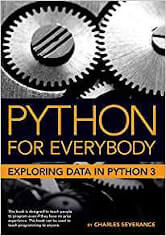 Python for Everybody is designed to introduce students to programming and software development through the lens of exploring data.
Python for Everybody is designed to introduce students to programming and software development through the lens of exploring data.
You can think of the Python programming language as your tool to solve data problems that are beyond the capability of a spreadsheet.
Python is an easy to use and easy to learn programming language that is freely available on Macintosh, Windows, or Linux computers. So once you learn Python you can use it for the rest of your career without needing to purchase any software.This book uses the Python 3 language.
Next page: Page 7 – Modeling Creativity: Case Studies in Python and more books
Pages in this article:
Page 1 – Think Python and more books
Page 2 – Supporting Python 3 and more books
Page 3 – Invent Your Own Computer Games with Python and more books
Page 4 – Making Games with Python & Pygame and more books
Page 5 – Hacking Secret Ciphers with Python and more books
Page 6 – Learn Python, Break Python and more books
Page 7 – Modeling Creativity: Case Studies in Python and more books
Page 8 – Python in Hydrology and more books
Page 9 – Tiny Python 3.6 Notebook and more books
All books in this series:
| Free Programming Books | |
|---|---|
| Ada | ALGOL-like programming language, extended from Pascal and other languages |
| Agda | Dependently typed functional language based on intuitionistic Type Theory |
| Arduino | Inexpensive, flexible, open source microcontroller platform |
| Assembly | As close to writing machine code without writing in pure hexadecimal |
| Awk | Versatile language designed for pattern scanning and processing language |
| Bash | Shell and command language; popular both as a shell and a scripting language |
| BASIC | Beginner’s All-purpose Symbolic Instruction Code |
| C | General-purpose, procedural, portable, high-level language |
| C++ | General-purpose, portable, free-form, multi-paradigm language |
| C# | Combines the power and flexibility of C++ with the simplicity of Visual Basic |
| Clojure | Dialect of the Lisp programming language |
| ClojureScript | Compiler for Clojure that targets JavaScript |
| COBOL | Common Business-Oriented Language |
| CoffeeScript | Transcompiles into JavaScript inspired by Ruby, Python and Haskell |
| Coq | Dependently typed language similar to Agda, Idris, F* and others |
| Crystal | General-purpose, concurrent, multi-paradigm, object-oriented language |
| CSS | CSS (Cascading Style Sheets) specifies a web page’s appearance |
| D | General-purpose systems programming language with a C-like syntax |
| Dart | Client-optimized language for fast apps on multiple platforms |
| Dylan | Multi-paradigm language supporting functional and object-oriented coding |
| ECMAScript | Best known as the language embedded in web browsers |
| Eiffel | Object-oriented language designed by Bertrand Meyer |
| Elixir | Relatively new functional language running on the Erlang virtual machine |
| Erlang | General-purpose, concurrent, declarative, functional language |
| F# | Uses functional, imperative, and object-oriented programming methods |
| Factor | Dynamic stack-based programming language |
| Forth | Imperative stack-based programming language |
| Fortran | The first high-level language, using the first compiler |
| Go | Compiled, statically typed programming language |
| Groovy | Powerful, optionally typed and dynamic language |
| Haskell | Standardized, general-purpose, polymorphically, statically typed language |
| HTML | HyperText Markup Language |
| Icon | Wide variety of features for processing and presenting symbolic data |
| J | Array programming language based primarily on APL |
| Java | General-purpose, concurrent, class-based, object-oriented, high-level language |
| JavaScript | Interpreted, prototype-based, scripting language |
| Julia | High-level, high-performance language for technical computing |
| Kotlin | More modern version of Java |
| LabVIEW | Designed to enable domain experts to build power systems quickly |
| LaTeX | Professional document preparation system and document markup language |
| Lisp | Unique features - excellent to study programming constructs |
| Logo | Dialect of Lisp that features interactivity, modularity, extensibility |
| Lua | Designed as an embeddable scripting language |
| Markdown | Plain text formatting syntax designed to be easy-to-read and easy-to-write |
| Objective-C | Object-oriented language that adds Smalltalk-style messaging to C |
| OCaml | The main implementation of the Caml language |
| Pascal | Imperative and procedural language designed in the late 1960s |
| Perl | High-level, general-purpose, interpreted, scripting, dynamic language |
| PHP | PHP has been at the helm of the web for many years |
| PostScript | Interpreted, stack-based and Turing complete language |
| Prolog | A general purpose, declarative, logic programming language |
| PureScript | Small strongly, statically typed language compiling to JavaScript |
| Python | General-purpose, structured, powerful language |
| QML | Hierarchical declarative language for user interface layout - JSON-like syntax |
| R | De facto standard among statisticians and data analysts |
| Racket | General-purpose, object-oriented, multi-paradigm, functional language |
| Raku | Member of the Perl family of programming languages |
| Ruby | General purpose, scripting, structured, flexible, fully object-oriented language |
| Rust | Ideal for systems, embedded, and other performance critical code |
| Scala | Modern, object-functional, multi-paradigm, Java-based language |
| Scheme | A general-purpose, functional language descended from Lisp and Algol |
| Scratch | Visual programming language designed for 8-16 year-old children |
| SQL | Access and manipulate data held in a relational database management system |
| Standard ML | General-purpose functional language characterized as "Lisp with types" |
| Swift | Powerful and intuitive general-purpose programming language |
| Tcl | Dynamic language based on concepts of Lisp, C, and Unix shells |
| TeX | Markup and programming language - create professional quality typeset text |
| TypeScript | Strict syntactical superset of JavaScript adding optional static typing |
| Vala | Object-oriented language, syntactically similar to C# |
| VHDL | Hardware description language used in electronic design automation |
| VimL | Powerful scripting language of the Vim editor |
| XML | Rules for defining semantic tags describing structure ad meaning |
